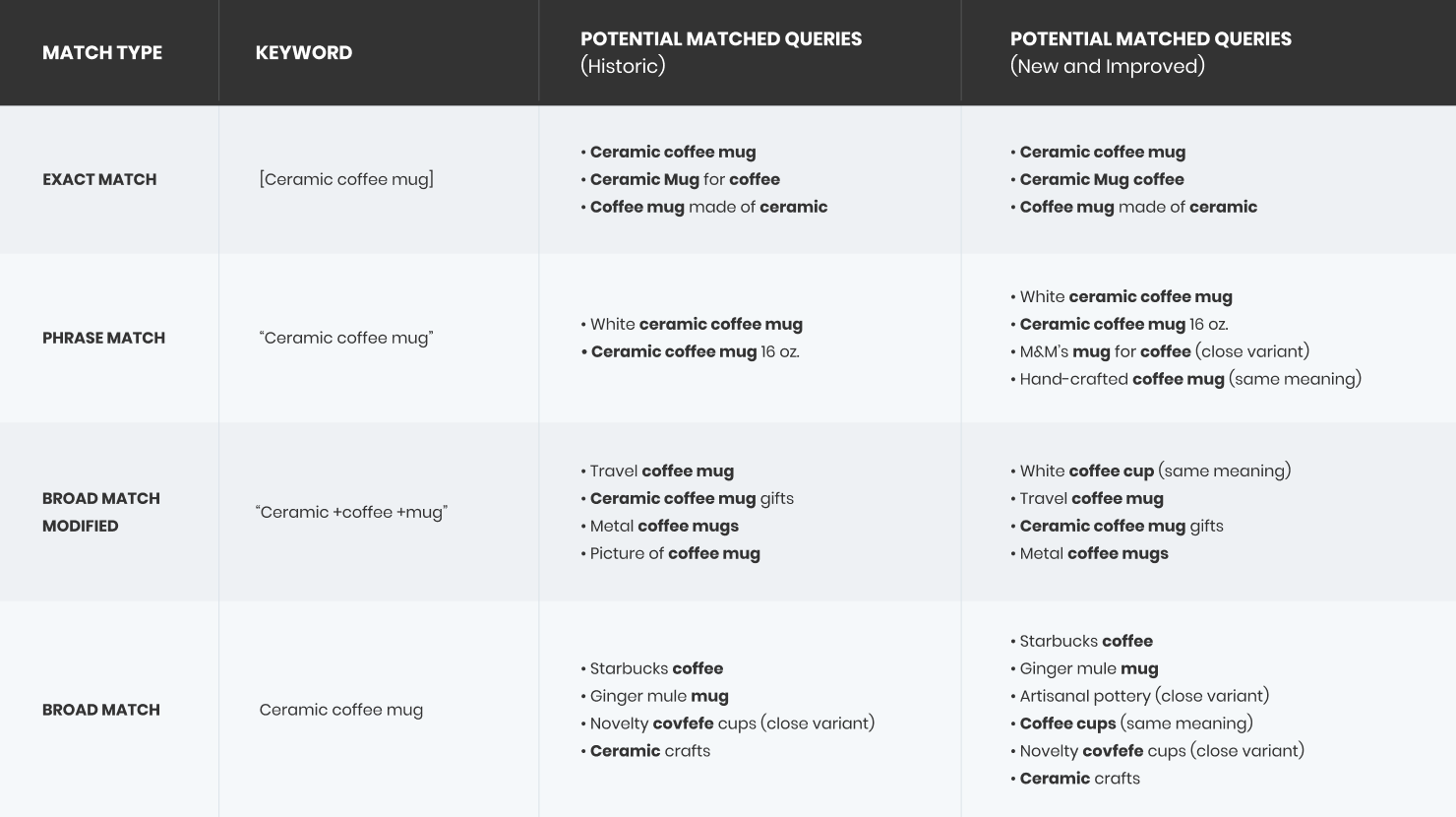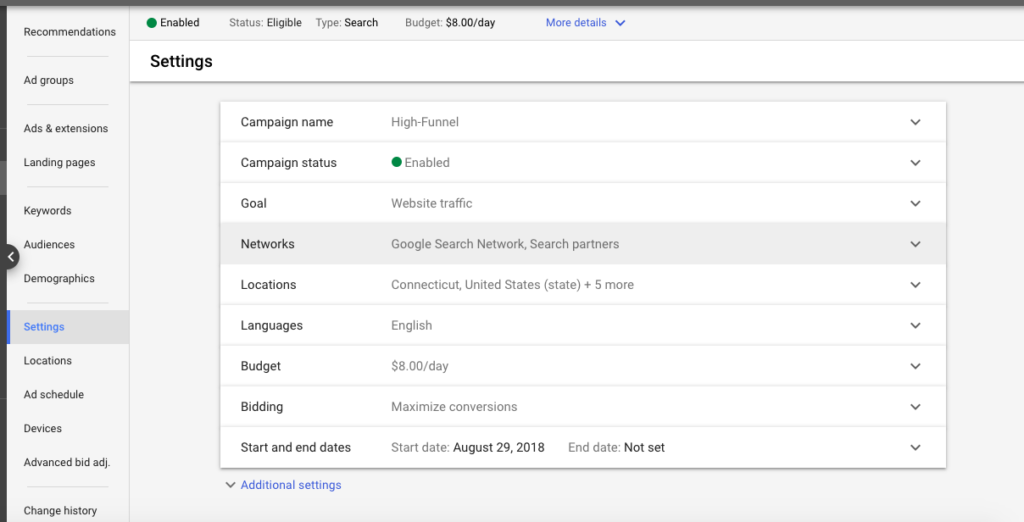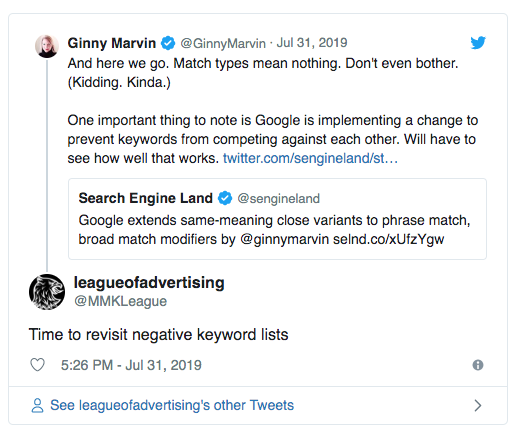About Match Types • Why Google is Doing This • What This Means for Advertisers • How to Prepare
You may have heard the news: Google is once again expanding close variants and same-meaning queries to include phrase match and broad match keywords in Google Ads. Following close on the heels of what must have been a successful expansion of exact match keywords, this latest change–which is rolling out “in the coming weeks”–promises to drive more traffic: between 3 and 4 percent more traffic, to be exact, a whopping 85 percent of which will come from queries not covered by search advertisers’ current keyword sets.
There are a lot of advertisers who are panicking in the wake of this news, if not about the change itself, then about what it portends for the future of search marketing. But the reality is that Google makes changes to Ads pretty frequently, and this update–although wider-reaching than most–really represents an opportunity to get your marketing efforts more closely aligned.
For starters, here’s a brief breakdown of what’s changing to get you caught up on what Google Ads match types used to look like, and what they look like now:

Given all of that, it’s not surprising that many SMB marketers took the news like sandpaper on a chalkboard (did I get that analogy right?). The reality is that the changes will probably cost SMBs more money in the short term, but it’s something that all marketers should have been prepared for given what Google’s been doing lately, even prior to the exact match close variant change. While it’s not empirically true that one type of keyword costs more than another, the less specific the match type, the higher the potential cost of a keyword. One of the most important factors contributing to Ad Rank is the relevance of a keyword to its matched query. Less specific keywords are typically less relevant to their matched query, so they typically have higher costs. Apart from this, less specific keywords generally have lower click-through and conversion rates.
In the almost 20 years since Google launched Google Ads (nee AdWords), they’ve made myriad changes to the offering with an aim of providing more options to advertisers and stronger results for brands. For the first 10 years of the platform’s existence, Google didn’t mess with keywords, with the exception of adding broad match modifier keywords in 2010.
It all changed in 2012, when Google began rolling out close variants in exact and phrase match keywords. In 2014, Google began mandating close variants in all campaigns, marking the beginning of the end for exact match keywords. Word order and function words were added to close variants for exact match in 2017. Exact match keywords could trigger queries with different word order and function words. Last fall, Google added same-meaning words to exact match close variants. This included implied words and paraphrases, marking the first time that Google really began to flex its AI muscles in relation to its ad product.
While Google is continuously making updates to the Google Ads platform, these recent updates have been pointing in a very particular direction, which we’ll touch on a bit more shortly.
Why Is Google Doing This (To Me)?
There are plenty of reasons for Google to make this change, and while some of them lend themselves to the cynical (Google’s such a monolith that they can do whatever they want, and similar refrains), the reality is simpler. Google processes over five billion searches each day, with somewhere around 30 million of those coming from voice search. That’s over two trillion searches each year, 360 million of which use voice assistants. What we’re trying to say is this: Google knows how we talk, and with each passing day it learns more about what we mean when we query its database.
It stands to reason that Google is also striving to align its search products as closely as possible. Anyone who has kept up with the evolving world of SEO knows that it’s only been in the past few years that a method for winning with SEO has been developed, and those same people know that optimizing content is still part art, part science. As Google learns more about how we search, it’s better able to serve us the results that we’re looking for, from both a paid and organic perspective. Ultimately, this means that organic performance and paid performance are going to more closely resemble each other as these changes take hold.
What does it all mean?
In the short term, it means that you should probably get rid of those single-match type ad groups, because otherwise you risk bidding against yourself for Ad Rank, which could drive up your costs. We’ll talk more about this in a second.
The bigger picture is much more important: this update isn’t happening in a vacuum. It’s now part of a trend where Google Ads is continuously expanding the reach of keywords, limiting advertisers’ control over the placements they earn and the audiences they reach. It’s not likely that this is the end of the line for these types of updates, and in fact many marketers believe that we’re speeding towards a zero-keyword search campaign world.
What are zero-keyword search campaigns? Rather than selecting the keywords you bid on, Google determines the keywords your ads are eligible to serve on based upon its index of your landing page. If that thought is intimidating, it shouldn’t be: Google’s already doing this with its Dynamic ad types, as well as Local, Smart and App campaigns.
How to Prepare for Google Ads’ Close Variant and Same Meaning Updates
Let’s dispense with the hypotheticals and talk about what we need to do to continue to achieve success in this brave new world. It’s exciting that we may see a 3 to 4 percent increase in click volumes, and significant increases in traffic from new queries, but how can we be sure that all that new traffic is traffic we actually want? Here are a few things you can do to make sure you’re still getting the strongest return from your search ads:
Automate bidding
If you’re not already using a smart bidding strategy on your conversion-focused campaigns, now is the time to start doing so. Smart bidding allows Google to increase or decrease keyword bids based upon the expected conversion rate and value, meaning that keywords whose value is lower because their matched queries are less qualified don’t wind up costing you a fortune.
Setting up automated bidding is fairly simple. When you open up your Google Ads account, you can open the campaign you’d like to automate bidding for and select Settings on the left-hand column menu. That’ll open up a menu that looks like this:

Choose from one of the following automated bidding strategies:
- Maximize Clicks – Helps your ads receive as many clicks as possible.
- Target Impression Share – Helps your ads get shown on the top of SERPs.
- Target Cost-per-Acquisition – Ads generate as many leads as your budget supports.
- Target Return on Ad Spend – Helps your ads get the highest return on ad spend.
- Maximize Conversions – Ads produce the maximum conversion volume possible.
- Maximize Conversion Value – Helps your ads get the largest conversion value.
They all work within your budget, meaning you won’t run the risk of spending more than your digital advertising budget on serving your ads to users.
Change your perception, then your attribution model
We know you’re not still using last-click attribution conversion modeling, but suppose a friend of yours is and wants to know how to better optimize their campaigns in this new world. Using last-click attribution may mean that close variants that play a crucial role in introducing new users to your brand or in impacting sales get devalued by Google, with the end result that those close variants may see their bids reduced so much that they no longer serve.
If you are still using last-click attribution and need to determine what a more optimal form of attribution may be for your brand, you’ll need to understand what the role of search advertising is in your buyer’s journey. An agency like Raka can help you define your buyer’s journey and identify which attribution model will work best.
Ensure your budgets are sufficient
It’s never great to have limited budgets, because that means your ads could stop serving before the end of the day, costing you valuable impressions, traffic or conversions. In a close variant- and similar meaning-filled world, limited budgets could be even more disastrous, because it could mean that your more valuable keywords aren’t eligible to serve ads even earlier along.
Audit your negative keywords
Your negative keyword lists should be evolving on a regular basis, whether by way of a script or by manually reviewing search query reports. Now more than ever, it’s important to make sure that your negative keyword lists are applied correctly throughout your Google Ads account, because they’ll impact the close variants and similar meaning terms that your ads are eligible to serve on.

Monitor, monitor, monitor
Whatever you do or don’t do, monitoring the performance of your keywords is going to be the most important thing you can do early on as these changes take hold. Monitoring performance manually will help you to get a feel for the changes that are occurring in your account, but ultimately it’s untenable to expect that you’ll be able to manually stay on top of these changes. An agency can help you implement a script that can help you automate negative keywords.
How to prepare for zero-keyword campaigns
If you’ve been paying attention to all your marketing channels, zero-keyword campaigns represent an opportunity, not a reason to panic. If you’ve been committed to creating quality content, engaging your audience with multimedia, developing a dedicated social following and building a compelling user experience on your site, the zero-keyword world presents limitless opportunities for growth.
If you haven’t been doing all of these things, it’s not too late to start. Here’s a few things your agency can help you can do to prepare for search marketing after keywords:
Identify your buyer personas
Your audience is composed of many different people with different roles, responsibilities, needs and interests. Being able to properly segment them will help with all of your marketing efforts, not just a zero-keyword world.
Build and execute a content strategy
Once you know who you’re creating content for, creating a content strategy that addresses the needs of each persona should be a breeze. Remember that your content strategy shouldn’t focus only on blog posts, but should also spotlight corporate website content and should feature multimedia such as video, infographic and interactive content.
It’s also not enough to create the content, you need to make sure that it’s optimized for search engines, users and advertising traffic. Make sure the pages hosting the assets load quickly, are mobile-optimized and utilize proper meta tagging and schema markup. This content should have a featured role in your zero-keyword advertising efforts, meaning that it should appeal to users who find it organically as well as those who are pointed to it from an advertising campaign–essentially, it needs to work for everyone.
Conduct a user experience audit
One of the most important ways to improve the performance of your site, landing pages or mobile app is to make sure that important content is easy to find. A user experience audit is a great way to make sure that your advertising traffic will easily be able to find the information it needs on your site, and it’s also a best practice for SEO inasmuch as it helps to increase time on site and decrease bounce rate.
If you have any questions about how to operate in a post-keyword world, don’t hesitate to contact Raka to learn how we can help you plan ahead and optimize your advertising for what’s to come.





